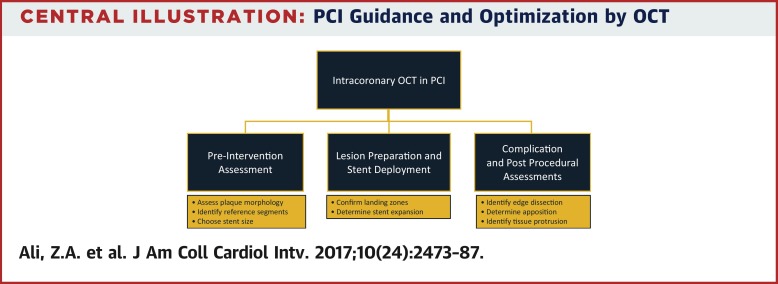


- 急性冠脉综合征
- 动脉粥样硬化性心血管疾病
- 分叉支架
- 心脏肿瘤科
- 充血性心力衰竭
- 双重抗血小板治疗持续时间
- 药物涂层球囊
- 血流储备分数
- 血管内超声指导
- 光学相关断层扫描
- 肺动脉高压
- 旋磨术
- 血流动力学与动脉粥样硬化
- 左主干支架
- 经导管主动脉瓣置换
- 经皮左心耳封堵
- 二尖瓣/三尖瓣瓣膜
- 推荐文献
-
 Intracoronary Optical Coherence Tomography 2018: Current Status and Future DirectionsAli ZA, Karimi Galougahi K, Maehara A et al.
Intracoronary Optical Coherence Tomography 2018: Current Status and Future DirectionsAli ZA, Karimi Galougahi K, Maehara A et al. -
 Fate of post-procedural malapposition of everolimus-eluting polymeric bioresorbable scaffold and everolimus-eluting cobalt chromium metallic stent in human coronary arteries: sequential assessment with optical coherence tomography in ABSORB Japan trialSotomi Y, Onuma Y, Dijkstra J et al.
Fate of post-procedural malapposition of everolimus-eluting polymeric bioresorbable scaffold and everolimus-eluting cobalt chromium metallic stent in human coronary arteries: sequential assessment with optical coherence tomography in ABSORB Japan trialSotomi Y, Onuma Y, Dijkstra J et al. -
 Optical coherence tomography findings: insights from the “randomised multicentre trial investigating angiographic outcomes of hybrid sirolimus-eluting stents with biodegradable polymer compared with everolimus-eluting stents with durable polymer in chronic total occlusions” (PRISON IV) trialTeeuwen K, Spoormans EM, Bennett J et al.
Optical coherence tomography findings: insights from the “randomised multicentre trial investigating angiographic outcomes of hybrid sirolimus-eluting stents with biodegradable polymer compared with everolimus-eluting stents with durable polymer in chronic total occlusions” (PRISON IV) trialTeeuwen K, Spoormans EM, Bennett J et al. -
 Comparison of Stent Expansion Guided by Optical Coherence Tomography Versus Intravascular Ultrasound: The ILUMIEN II Study (Observational Study of Optical Coherence Tomography [OCT] in Patients Undergoing Fractional Flow Reserve [FFR] and Percutaneous Coronary Intervention)Maehara A, Ben-Yehuda O, Stone GW et al.
Comparison of Stent Expansion Guided by Optical Coherence Tomography Versus Intravascular Ultrasound: The ILUMIEN II Study (Observational Study of Optical Coherence Tomography [OCT] in Patients Undergoing Fractional Flow Reserve [FFR] and Percutaneous Coronary Intervention)Maehara A, Ben-Yehuda O, Stone GW et al. -
 Combining IVUS and Optical Coherence Tomography for More Accurate Coronary Cap Thickness Quantification and Stress/Strain Calculations: A Patient-Specific Three-Dimensional Fluid-Structure Interaction Modeling ApproachGuo X, Giddens DP, Molony D et al.
Combining IVUS and Optical Coherence Tomography for More Accurate Coronary Cap Thickness Quantification and Stress/Strain Calculations: A Patient-Specific Three-Dimensional Fluid-Structure Interaction Modeling ApproachGuo X, Giddens DP, Molony D et al. -
 Optical coherence tomography imaging during percutaneous coronary intervention impacts physician decision-making: ILUMIEN I studyWijns W, Shite J, Jones MR et al.
Optical coherence tomography imaging during percutaneous coronary intervention impacts physician decision-making: ILUMIEN I studyWijns W, Shite J, Jones MR et al. -
 Intracoronary Optical Coherence Tomography-Derived Virtual Fractional Flow Reserve for the Assessment of Coronary Artery DiseaseSeike F, Uetani T, Nishimura K et al.
Intracoronary Optical Coherence Tomography-Derived Virtual Fractional Flow Reserve for the Assessment of Coronary Artery DiseaseSeike F, Uetani T, Nishimura K et al. -
 Optical coherence tomography compared with intravascular ultrasound and with angiography to guide coronary stent implantation (ILUMIEN III: OPTIMIZE PCI): a randomised controlled trialAli ZA, Stone GW; ILUMIEN III: OPTIMIZE PCI Investigators.
Optical coherence tomography compared with intravascular ultrasound and with angiography to guide coronary stent implantation (ILUMIEN III: OPTIMIZE PCI): a randomised controlled trialAli ZA, Stone GW; ILUMIEN III: OPTIMIZE PCI Investigators.
-
Intracoronary Optical Coherence Tomography 2018: Current Status and Future Directions
-
Fate of post-procedural malapposition of everolimus-eluting polymeric bioresorbable scaffold and everolimus-eluting cobalt chromium metallic stent in human coronary arteries: sequential assessment with optical coherence tomography in ABSORB Japan trial
-
Optical coherence tomography findings: insights from the “randomised multicentre trial investigating angiographic outcomes of hybrid sirolimus-eluting stents with biodegradable polymer compared with everolimus-eluting stents with durable polymer in chronic total occlusions” (PRISON IV) trial
-
Comparison of Stent Expansion Guided by Optical Coherence Tomography Versus Intravascular Ultrasound: The ILUMIEN II Study (Observational Study of Optical Coherence Tomography [OCT] in Patients Undergoing Fractional Flow Reserve [FFR] and Percutaneous Coronary Intervention)
-
Combining IVUS and Optical Coherence Tomography for More Accurate Coronary Cap Thickness Quantification and Stress/Strain Calculations: A Patient-Specific Three-Dimensional Fluid-Structure Interaction Modeling Approach
-
Optical coherence tomography imaging during percutaneous coronary intervention impacts physician decision-making: ILUMIEN I study
-
Intracoronary Optical Coherence Tomography-Derived Virtual Fractional Flow Reserve for the Assessment of Coronary Artery Disease
-
Optical coherence tomography compared with intravascular ultrasound and with angiography to guide coronary stent implantation (ILUMIEN III: OPTIMIZE PCI): a randomised controlled trial




















